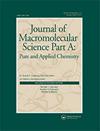干式卷绕用阻燃环氧预浸纱的制备及性能研究
IF 2.4
3区 化学
Q3 POLYMER SCIENCE
Journal of Macromolecular Science Part A-Pure and Applied Chemistry
Pub Date : 2023-09-12
DOI:10.1080/10601325.2023.2253838
引用次数: 0
摘要
摘要干绕成形过程中缠绕张力均匀,工艺易于控制,制备的车载氢复合材料压力容器结构性能稳定。由于车载氢气压力容器必须经过严格的防火试验,目前阻燃环氧预浸纱技术被国外所垄断。开发加工性能良好的阻燃预浸纱对氢压力容器的推广应用具有重要意义。合成了一种阻燃添加剂六苯基环三磷腈(HPCTP),并将其溶解在P/N-EP预浸纱的环氧树脂中。然后,采用溶液浸渍法制备阻燃预浸纱。研究了P/N-EP阻燃预浸纱的固化性能、热分析、燃烧性能、力学性能和拉伸性能。实验结果表明,在10 phr时LOI值达到36.4%,达到UL-94测试的V-0水平。P-N/EP树脂体系的热稳定性结果表明,随着P-N含量的增加,T5%(失重5%温度)和CY600(残炭率)均增加。采用电子显微镜和激光拉曼光谱仪对UL-94试验后的残炭微观结构进行了研究。结果表明:随着P-N含量的增加,碳层结构变得更加致密,ID/IG显著降低,通过凝聚相机制达到阻燃效果;关键词:阻燃环氧预浸料纱线缠绕机械性能披露声明作者未报告潜在利益冲突。本研究由吉林省智能制造重大科技专项(20210301004GX)资助。本文章由计算机程序翻译,如有差异,请以英文原文为准。
Preparation and properties of flame-retardant epoxy prepreg yarn for dry winding
AbstractThe winding tension of the dry-wound forming process is uniform, the process is easy to control and the structure and performance of the prepared vehicle-mounted hydrogen composite pressure vessels are stable. Since the vehicle-mounted hydrogen pressure vessels must be subjected to rigorous fire experiments, the flame-retardant epoxy prepreg yarn technology is currently monopolized by foreign countries. The development of flame-retardant prepreg yarn with good processing properties is of great significance to the promotion and application of hydrogen pressure vessels. Here, a flame-retardant additive hexaphenoxy cyclotriphosphazene (HPCTP) was synthesized and dissolved in epoxy resin of prepreg yarn named P/N-EP. Then, the flame-retardant prepreg yarn was made by the solution impregnation method. Curing behavior, thermal analysis combustion behavior and mechanical properties of P/N-EP and tensile properties of flame-retardant prepreg yarn were investigated. Experimental results showed that the LOI value reached 36.4% at 10 phr and reached the V-0 level of the UL-94 test. The results about thermal stability of the P-N/EP resin system showed that with the increase of P-N content, T5% (temperature at 5% weight loss) and CY600 (carbon residue rate) both increased. The microstructure of carbon residue after UL-94 test was studied by electron microscope and laser Raman spectrometer. The results showed that with the increase of P-N content, the carbon layer structure became denser and the ID/IG decreased significantly, to achieve the flame-retardant effect by the condensed phase mechanism.Keywords: Flame-retardantepoxy prepreg yarndry windingmechanical properties Disclosure statementNo potential conflict of interest was reported by the authors.Additional informationFundingThis work was supported by Jilin Province intelligent manufacturing major science and technology project (20210301004GX).
求助全文
通过发布文献求助,成功后即可免费获取论文全文。
去求助
来源期刊
CiteScore
4.60
自引率
16.00%
发文量
61
审稿时长
3.1 months
期刊介绍:
Journal of Macromolecular Science, Part A: Pure and Applied Chemistry (JMS-PAC) is a necessary resource for academic and industrial scientists and engineers whose interests center on both synthetic and naturally occurring polymers and their applications.

 求助内容:
求助内容: 应助结果提醒方式:
应助结果提醒方式:


